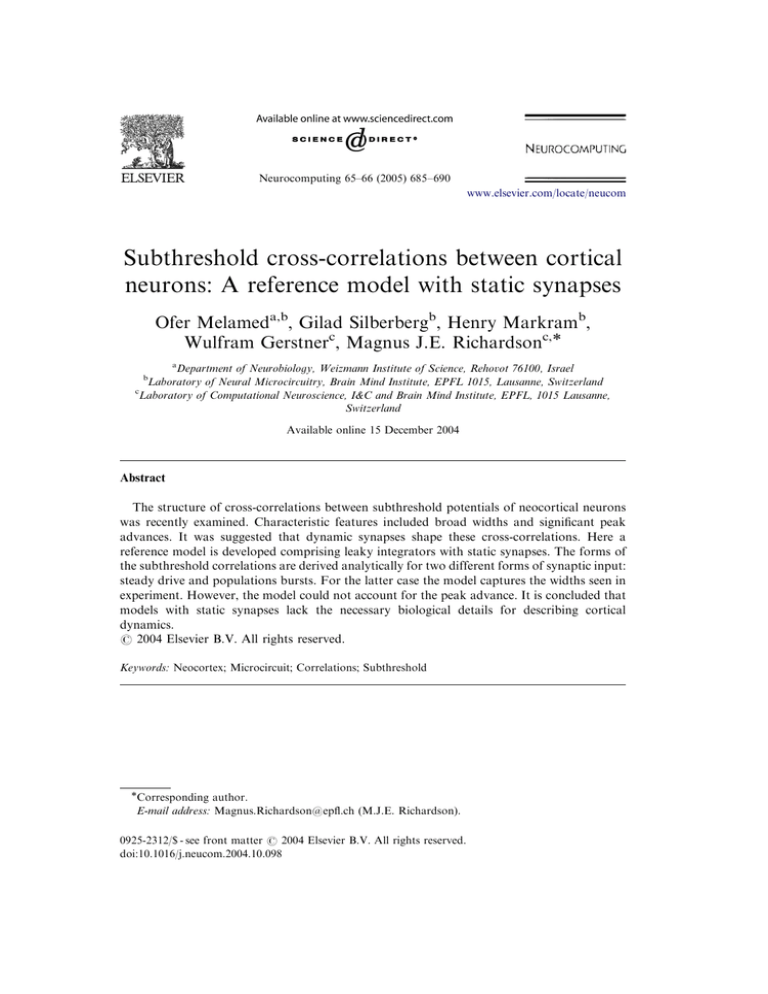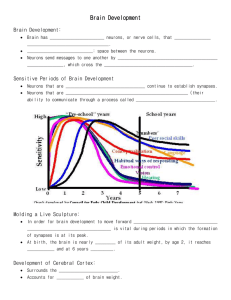
ARTICLE IN PRESS
Neurocomputing 65–66 (2005) 685–690
www.elsevier.com/locate/neucom
Subthreshold cross-correlations between cortical
neurons: A reference model with static synapses
Ofer Melameda,b, Gilad Silberbergb, Henry Markramb,
Wulfram Gerstnerc, Magnus J.E. Richardsonc,
a
Department of Neurobiology, Weizmann Institute of Science, Rehovot 76100, Israel
Laboratory of Neural Microcircuitry, Brain Mind Institute, EPFL 1015, Lausanne, Switzerland
c
Laboratory of Computational Neuroscience, I&C and Brain Mind Institute, EPFL, 1015 Lausanne,
Switzerland
b
Available online 15 December 2004
Abstract
The structure of cross-correlations between subthreshold potentials of neocortical neurons
was recently examined. Characteristic features included broad widths and significant peak
advances. It was suggested that dynamic synapses shape these cross-correlations. Here a
reference model is developed comprising leaky integrators with static synapses. The forms of
the subthreshold correlations are derived analytically for two different forms of synaptic input:
steady drive and populations bursts. For the latter case the model captures the widths seen in
experiment. However, the model could not account for the peak advance. It is concluded that
models with static synapses lack the necessary biological details for describing cortical
dynamics.
r 2004 Elsevier B.V. All rights reserved.
Keywords: Neocortex; Microcircuit; Correlations; Subthreshold
Corresponding author.
E-mail address: Magnus.Richardson@epfl.ch (M.J.E. Richardson).
0925-2312/$ - see front matter r 2004 Elsevier B.V. All rights reserved.
doi:10.1016/j.neucom.2004.10.098
ARTICLE IN PRESS
686
O. Melamed et al. / Neurocomputing 65–66 (2005) 685–690
1. Introduction
Exploring correlated activity between neurons is essential for the understanding of
how information is processed in cortex. A recent experimental study examined
correlations of subthreshold voltage due to the network activity in an active cortical
slice [5]. The subthreshold voltage responds to the activity of many thousands of
presynaptic cells and contains more information than the spike trains [3,6,7], which
have been the subject of previous correlation studies (see [8] for an informationtheoretic approach). In the slice experiment [5] the cortical network was in one of
two states, either a steady-firing state or a state in which the network had
intermittent bursts of activity. In each experiment subthreshold activity was
measured from two neurons. The experimental paradigm involved the injection of
a hyperpolarizing current bringing the neurons near to the reversal potential for
inhibition, thereby keeping the neurons in the subthreshold regime and isolating the
excitatory input. For the case where the network was in the steady firing state the
cross-correlation was sharply peaked and centered near zero. However, for the case
of population bursts the characteristic features of the cross-correlation were broad
widths (100 ! 500 ms for the case of population bursts) and a significant advance to
the peak (50–100 ms between pyramidal and certain interneuron types).
Here, it is examined whether a simple model comprising a pair of leaky integrators
with static synapses is sufficient to capture these basic experimental features. The
paper closes with an examination of the descriptive scope of models with static
synapses and of possible extensions that might allow for a better agreement with
experimental observations.
2. The model
Two leaky integrator neurons (having no spike mechanism) with membrane
potentials V 1 ðtÞ and V 2 ðtÞ; receive input from a common and separate pool of
presynaptic neurons. Only excitatory post-synaptic potentials (EPSPs) are considered, consistent with the experimental procedure described above. (Synaptic
conductance changes will be ignored. However, it will be shown later that our
conclusions are not affected by this approximation.) The dynamics of the
subthreshold potential, subject to a synaptic input I syn ; obey
qX
t tk
_
tm V ¼ V þ RI syn ðtÞ where I syn ðtÞ ¼
Yðt tk Þ exp :
tf ft g
tf
k
The quantities introduced are: tm the membrane time constant, R the neuronal
input resistance, tf the falling time constant, q is the total amount of charge in a
synaptic current pulse and ftk g the set of arrival times for all synaptic inputs.
These parameters will be later subscripted by the labels 1,2 for each of the
neurons. The subthreshold potential above is measured from the reversal
potential of the inhibitory drive (near 70 mV) and can be written as a summation
ARTICLE IN PRESS
O. Melamed et al. / Neurocomputing 65–66 (2005) 685–690
of EPSPs EðtÞ
Z
V ðtÞ ¼
1
ds EðsÞ
0
X
dðs ðt tk ÞÞ
with EðtÞ ¼ qR
ftk g
687
ðet=tm et=tf Þ
YðtÞ:
ðtm tf Þ
(1)
3. The cross-correlation function
Throughout this paper, the cross-correlation function is defined as follows
CðDÞ ¼ /V 1 ðtÞV 2 ðt þ DÞS /V 1 S/V 2 S;
(2)
where it is stressed that the amplitude of CðDÞ is not normalized. Inserting the form
of the voltage given in Eq. (1) yields
Z 1Z 1
ds1 ds2 E1 ðs1 ÞE2 ðs2 Þ½rc dðs1 s2 þ DÞ þ r0 rðs1 s2 þ DÞ r20 ;
CðDÞ ¼
0
0
(3)
where rc is the average common rate and r0 is the average total rate. The quantity
rðtÞ is the cross-conditional probability of finding a pulse at a time t in the input of
one neuron given a pulse at t ¼ 0 in the input of the other.
3.1. Steady synaptic drive
For Poissonian input the cross-conditional density is constant rS ðtÞ ¼ r0 giving the
cross-correlation function for D40 as
Z 1
CS ðDÞ ¼ rc
ds E1 ðsÞE2 ðs þ DÞ
0
¼ rc q1 q2 R1 R2 ðM 12 eD=m2 F 12 eD=f 2 Þ;
ð4Þ
m22
M 12 ¼
1
;
ðm2 f 2 Þ ðm1 þ m2 Þðm2 þ f 1 Þ
F 12 ¼
1
f 22
:
ðm2 f 2 Þ ðf 1 þ f 2 Þðm1 þ f 2 Þ
The notation has been lightened by writing m1 for tm1 etc. The cross-correlation
function for Do0 takes a similar form, but with the indices and sign of D reversed,
i.e. X 12 ðDÞ is replaced by X 21 ðDÞ:
The peak and mean advance: The time difference DS at which the cross-correlation
function peaks has the same sign as m2 f 2 m1 f 1 : When DS 40
m2 f 2
m2 ðf 1 þ f 2 Þðm1 þ f 2 Þ
DS ¼ log
(5)
V 1 leads V 2 :
ðm2 f 2 Þ
f 2 ðm1 þ m2 Þðm2 þ f 1 Þ
The advance can also be measured in terms of the moments of CS ðDÞ: The mean
advance is DS ¼ ðf 2 þ m2 Þ ðf 1 þ m1 Þ and of the order of the membrane and
ARTICLE IN PRESS
Voltage (mV)
5
Cross-Correlation (mV2)
O. Melamed et al. / Neurocomputing 65–66 (2005) 685–690
688
Steady Drive
4
3
2
1
0
0
500
Theory
30sec Simulation
0
-150
-100
-50
0
100
50
150
Cross-Correlation (mV2)
(c)
5
Voltage (mV)
Steady Drive
0.005
1000
(a)
Population Bursts
4
3
2
1
0
0
(b)
0.01
500
1000
Time (ms)
0.5
Population Bursts
0.25
0
-150
(d)
Theory
30sec Simulation
-100
-50
0
50
100
150
Time Shift ∆ (ms)
Fig. 1. Results from numerical simulations. (LEFT) Voltage traces for the neuronal pair (neuron 1 is
black and offset by 2 mV, neuron 2 is grey) for the cases of steady Poissonian (a) and burst (b) synaptic
drive.
(RIGHT)
The
corresponding
cross-correlations.
The
parameters
used
are
ftm1 ¼ 20; tf1 ¼ 5; tm2 ¼ 25; tf2 ¼ 2g ms and q1 R1 ¼ q2 R2 ¼ 3; for both cases. For the steady input
the common and total rates were 50 and 200 Hz, respectively. For the population burst rcB ¼ 100 Hz;
rsB ¼ 400 Hz; T B ¼ 100 ms and T IBI ¼ 500 ms: The peak (Eq. 5) of the cross-correlation is 1:0 ms
(dashed line), and the mean is 2 ms (central dotted line). Neither of these are of the same magnitude as the
experimentally observed peak shifts. Widths (defined as twice the standard deviation, shown by the
flanking dotted lines) Poissonian drive (c) 64 ms, population bursts (d) 104 ms. The latter falls into the
range seen in experiment.
synaptic time constants ( 10 ms). This is an order of magnitude less than that seen
in experiment: the model cannot reproduce the experimental results. An example is
given in Fig. 1 (panel c) where the peak is negative and the mean positive, but both
located close to zero.
The width: This is obtained from the moments of the cross-correlation:
ðD DÞ2S ¼ m21 þ f 21 þ m22 þ f 22 :
(6)
Hence the width, measured as the square root of this quantity, is less than twice the
longest membrane or synaptic time-scale ( 10 s of ms: see Fig. 1 panel c) and again
this is less than that seen in experiment.
3.2. Population bursts
The population bursts are modeled here as a Poissonian distributed box-car
function, with the burst frequency rB ¼ rBc þ rBs where rBc and rBs are the common
ARTICLE IN PRESS
O. Melamed et al. / Neurocomputing 65–66 (2005) 685–690
689
and separate rates within the burst. The burst length is T B and the average interval
between the centers of bursts is T IBI : The low spike rate between bursts is
approximated as being equal to zero. The required cross-conditional density rðtÞ for
this type of presynaptic input is
8 < r 1 t þ r 0ojtjoT ;
B
0
B
TB
rB ðtÞ ¼
(7)
: r0
T B ojtj:
The average rate r0 is a function of the inter-burst interval r0 ¼ rB T B =T IBI as is the
common rate rc ¼ rBc T B =T IBI : The correlation function can be written in terms of a
convolution with US ¼ CS =rc
Z TB
jD0 j
CB ðDÞ ¼ CS ðDÞ þ rB r0
dD0 US ðD þ D0 Þ 1 :
(8)
TB
T B
Performing the integration gives the cross-correlation for D40 as
CB ðDÞ
rc
¼ ðM 12 eD=m2 F 12 eD=f 2 Þ
r0 q1 q2 R1 R2
r0
2rB
þ
ðM 12 m22 eD=m2 ðcoshðT B =m2 Þ 1ÞÞ
TB
2rB
ðF 12 f 22 eD=f 2 ðcoshðT B =f 2 Þ 1ÞÞ
TB
rB
YðT B DÞðT B D þ ðm2 þ f 2 Þ ðm1 þ f 1 ÞÞ
þ
TB
rB
YðT B DÞðM 21 m21 eðT B DÞ=m1 F 21 f 21 eðT B DÞ=f 1 Þ
þ
TB
rB
YðT B DÞðM 12 m22 eðT B DÞ=m2 F 12 f 22 eðT B DÞ=f 2 Þ:
TB
ð9Þ
The cross-correlation for Do0 is obtained by reversing all indices f1; 2g ! f2; 1g and
the sign of D:
The peak and mean advance: In the convolution Eq. (8), the width of the burst is
much greater than the steady-firing cross-correlation function. Hence DB ’ DS where
the small corrections would come from any skew in CS and it is seen that the burst
model also cannot explain the large peak advances seen in experiment. The mean
advance DB is also equivalent to the steady-input result DS given above. See Fig. 1
panel (d) for an example.
The width: The width is obtained approximately by using Eq. (8)
T 2B
(10)
6
noting that the common input (first term in Eq. (8)) is small compared to the withinburst correlations. The model therefore captures the large widths seen in experiment.
This is seen in the example given in Fig. 1 (panel d) in which even relatively short
bursts (100 ms) give a standard deviation that is almost twice the size of the
Poissonian case.
ðD DÞ2B ’ ðm21 þ f 21 þ m22 þ f 22 Þ þ
ARTICLE IN PRESS
690
O. Melamed et al. / Neurocomputing 65–66 (2005) 685–690
4. Discussion
In this study an analytical approach was developed to examine the neuronal and
synaptic mechanisms that underlie features of the cross-correlation seen between
cortical neurons [5]. The model comprised a pair of leaky integrator neurons with
static synapses subject to steady input or population bursts. We demonstrated that
the duration of the population bursts largely determines the width of the crosscorrelation (Eq. (10)). It was also seen in experiment that the peak of the crosscorrelation showed a significant shift from zero (50–100 ms for the cases of
correlations between pyramidal and certain interneuron types). However, Eq. (5)
and the derived formula for the mean cannot produce peak shifts of this order with
realistic synaptic kinetics and membrane parameters. It is concluded the model with
static synapses and passive membranes is not sufficiently detailed to explain the
dynamics of cortical microcircuits.
The model ignored the large synaptic conductance changes seen in neurons
embedded in active networks [1]. These effects are well approximated by a shorter
membrane time constant, which would only reinforce our conclusions. Another
mechanism ignored in this model is the dynamic nature of synapses [2,4]. That this
mechanism is likely to produce the peak shift is supported by the fact that the largest
peak delays were seen between neurons in which one received facilitating and the
other depressing synapses. The passive neuron models used here also neglected transmembrane currents. In particular, the I h current is strongly active at hyperpolarized
membrane potentials and has the long time-scale necessary for a mechanism that
might underlie the peak advance. These mechanisms need to be investigated
to analyze which might underlie the observations and thereby better model
the dynamics of the correlated activity in active cortical microcircuits, both in the
isolated brain slice and in vivo [3,6].
References
[1] A. Destexhe, D. Paré, Impact of network activity on the integrative properties of neocortical
pyramidal neurons in vivo, J. Neurophysiol. 81 (1999) 1531–1547.
[2] A. Gupta, Y. Wang, H. Markram, Organizing principles for a diversity of GABAergic interneurons
and synapses in the neocortex, Science 287 (2000) 273–278.
[3] I. Lampl, I. Reichova, D. Ferster, Synchronous membrane potential fluctuations in neurons of the cat
visual cortex, Neuron 22 (1999) 361–374.
[4] H. Markram, Y. Wang, M. Tsodyks, Differential signaling via the same axon of neocortical pyramidal
neurons, P. Natl. Acad. Sci. USA 95 (1998) 5323–5328.
[5] G. Silberberg, C.Z. Wu, H. Markram, Functional correlations between neocortical neurons, In ISNF,
Eilat. Weizmann Institute of Science.
[6] E.A. Stern, D. Jaeger, C.J. Wilson, Membrane potential synchrony of simultaneously recorded striatal
spiny neurons in vivo, Nature 394 (1998) 475–478.
[7] S. Stroeve, S. Gielen, Correlation between uncoupled conductance-based integrate-and-fire neurons
due to common and synchronous presynaptic firing, Neural Comput. 13 (2001) 2005–2029.
[8] S. Yamada, M. Nakashima, K. Matsumoto, S. Shiono, Information theoretic analysis of actionpotential trains. 1. Analysis of correlation between 2 neurons, Biol. Cybern. 68 (1993) 215–220.








